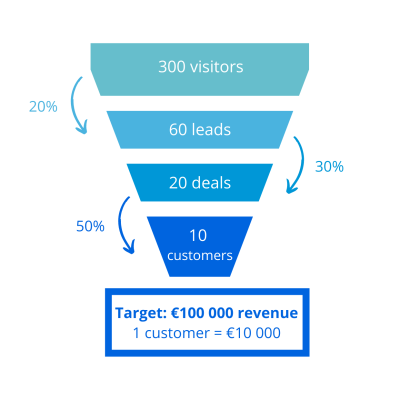4 steps to sales and marketing alignment
Every marketing professional knows this scenario. You set up a new lead generation campaign and views/clicks/leads are coming in. So, you deliver the leads to sales. Mission accomplished!Or not? After a few weeks, nothing has happened with your leads and you wonder why they are not followed up.
Every sales professional knows this scenario. You get a new list with marketing leads, but unfortunately, there is not much relevance in there. Only a few of them are part of your target companies and decision-makers. You cannot work with that. Marketing should find other leads.
Unfortunately, this scenario happens far too often, despite the fact that sales en marketing both have the best intentions. Marketing wants to deliver relevant leads, and sales wants to make time to follow up on them. So, where do things go wrong? Easy: a lack of sales and marketing alignment.
The importance of sales and marketing alignment
Sales en marketing alignment is a big part of your company’s success. If this machine is not running smoothly, this has unwanted internal and external effects.
Internally, frustrations can arise as in the scenarios above. Both teams give it their best, but lead generation and lead nurturing aren’t running as they should. This is not ideal for the quantity and quality of your leads.
Next to this, bad processes can have an impact on the experience of your customers and prospects.
- Mistakes in the handover from marketing to sales can lead to bad timing of the follow-up.
- When background information is not handed over properly, this can cause unclear or wrong messages towards the lead.
Clear communication and clear agreements between sales and marketing are important to create the right internal expectations and to guarantee a great customer experience. Results from CSO insights support this statement.

Service Level Agreements to the rescue
Sales and marketing alignment can only be enabled with mutual agreements. These can be part of your Service Level Agreement (SLA).
An SLA is a written agreement that describes what two teams will do to support each other to reach a common goal. It is not designed to point fingers, but to create some clarity on how both teams will work together.
An SLA can consist of many different elements. The most common are:
- Number of leads that marketing will generate
- Number of leads that marketing will handover to sales
- Amount of leads that sales will follow up
- In what timeframe sales will follow up a lead
- How many attempts there will be to follow up on a lead
- How marketing will handover the lead to sales
- How unqualified leads will get back to marketing
When you create an SLA, it is important to describe the efforts of each team as clearly as possible. Describe the deliverables (e.g. 300 MQLs), when they should be delivered (e.g. in 2022) and what should happen with the input (e.g. assign a sales contact owner in the CRM).
To create a successful SLA, you need to bring sales and marketing together to define concepts, so that everyone will interpret the SLA in the same way. Special attention should go to targets, the definition of a good lead, the handover process and refusing a lead.
Targets
When creating an SLA, you need to know your shared target. To define target, you can use conversion rates from the previous year and use them to make a bottom-up calculation for your funnel. We will explain this with an example.
Say you want to generate a revenue of €100.000 next year and you know every customer represents on average €10.000 in revenue. This means you need 10 customers to reach your target of €100.000. 10 new clients means you have to close 10 new deals.
You know based on your previous year that your conversion rate from opened to closed deals is 50%. That means you need to open 20 deals to win 10. To open deals, you need qualified leads. We know that 30% of our leads convert to a deal. So for 20 deals, you need 60 qualified leads. Qualified leads can visit you on different channels. If we know 20% of our online visitors will convert to a lead, this means we need 300 visitors to get to 60 qualified leads.
If you calculate your targets like this, you can make them a lot more tangible and you can link specific actions to your sales and marketing team.


What is a good lead?
The interpretation of the concept ‘a good lead’ can be different depending on the team you ask. For marketing, good leads are usually people who downloaded eBooks, watched webinars… Sales however will take into account other criteria like geography, industry and/or seniority. If sales wants to receive good leads from marketing, they will have to share their experiences about the market. In that way, marketing knows what leads are a good fit, who they should target and hand over to sales. You could compare this to a traffic light. If the criteria like geography, industry, seniority are met, the light will be green and we have a potential relevant lead for sales.
Apart from the demographics, lead engagement is also important. Once leads pass through the traffic light, you can look further into their interactions with your content. If a lead is very active (e.g. request a demo, fill in a contact form), he will get a higher priority in the follow-up list than someone who just checks a page now and then.
The handover
Most companies use life cycle stages as a framework for handing over leads from marketing to sales. Once a lead becomes a sales qualified lead (SQL), sales will start working on them. But what are the criteria for an SQL?Well, this is specific to your organisation, and should be defined together with the sales and marketing team.


You can use lead scoring to award points based on digital activity or engagement. It is up to you to decide what each activity is worth. When a lead has had sufficient interaction and gets to a certain amount of points, this could lead to an SQL status.
It is also possible that a very specific action (e.g. filling in a specific form, downloading a price list, reaching out directly to a contact person through your website chat…) is enough to qualify as an SQL immediately. We call these sales-ready actions. They show that a lead is very interested in your products or services, and it’s a sign that this person is ready to take the next step in the buyer’s journey. Sales-ready actions are also very specific for your organisation. Based on the experiences of your sales team, you can find out what your sales-ready actions are.
To ensure a smooth handover, communication is essential. In the first place, you need communication about what a good lead is. But next to that, you also have to discuss how that lead will get to sales. If you use a CRM, you can even automate this process with workflows. You could set up a workflow that assigns tasks to your sales colleagues to approve or reject a lead when he completed a sales-ready action ,or got a certain amount of points. This enables a smooth flow of information.
Rejecting leads
Despite the mutual understanding of what a good lead is and the use of a ‘traffic light’, it can happen that a lead is not qualified when it gets to sales (through sales-ready actions or a number of points). It is important that marketing gets this feedback from sales, so they can learn why the lead wasn’t relevant. This is the ideal moment to start optimizing your lead scoring, your definition of sales-ready actions, or even the definition of ‘a good lead’. These concepts can change over time.
To enable this information flow, it is important to install a lead rejection process and a feedback loop between sales and marketing.
Supporting content creation
An SLA creates more understanding between sales and marketing and a shared set of goals. However, both teams still have their own tasks.
Marketing is responsible for
- Attracting online visitors
- Social media engagement
- Lead conversion
- Lead nurturing (MQL)
Sales takes up the following tasks
- Lead nurturing (SQL)
- Creating proposals
- Closing deals
Despite their different tasks, both teams can support each other with their insights, especially in content creation.
On the one hand, marketing is responsible for creating the content, so they know what content is available in the different stages of the buyer’s journey. With a content cheat sheet, they can support the sales people with a list of available content.
On the other hand, the sales people are in direct contact with the market. Their insights into the target audience’s pain points are very valuable and can lead to new content ideas.
Sales and marketing alignment roadmap
It is clear that successful sales and marketing alignment is only possible with clear communication. Do you want to bring your sales and marketing alignment to the next level? In this blog, we described different phases of sales and marketing alignment. We list them one last time in a 4-step roadmap.
- Goals – SLA
Define your shared goals and describe in an SLA what every team will do to achieve them.
- What is a good lead
Engage in dialogue to co-define your ideal lead! Will you only take demographic criteria into account, or does lead engagement also play a part?
- Handover
Once you find good leads, sales can start working on them. Discuss in advance how they will receive information about a lead and how they can give feedback to marketing if it turns out that it was not a good lead. Do you like to use a CRM, or do you prefer another method?
- Content plan
Marketing will generate leads with strong content. With a content cheat sheet, you can provide an overview of your content in every phase of the buyer’s journey. The conversations of sales people with leads, prospects and customers are a very valuable source of inspiration for content production. Sharing these insights is a win-win for both sides of the sales and marketing spectrum.
Grow Significantly With Marketing Automation
Download our Ultimate Marketing Automation Guide and start growing your organisation significantly, starting today!






